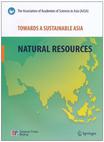通向可持续发展的亚洲
2011-1
科学出版社
本社 编
80
无
Asia is an important continent with population of 3.8 billion andconcentrates most developing countries in the world. Over the last severaldecades, many nations in Asia have seen quick economic development, whilesome strategic resources needs in Asia increase simultaneously. In the next20 years and even long terms of the 21st century natural resources demandin Asia will increase largely. Asia occupies the important position of theresources supply and demand in the world. It has not only some key resourcesproducing countries in the world, but main resources consuming countriesas well. Unfortunately, Asian economic progress in general has been achievedat a high cost. Under combined pressure of climatic change and humandisturbances, the natural environment in Asia has been steadily degrading,which compromises the future development and the livelihood of its hugeresidents. Impacts of climate change are especially visible in Asia on varioussectors including agriculture, forestry, biodiversity conservation, waterresources, human health, air quality, energy security, and others. Climatechange related environmental deteriorations in Asia are already serious, andwill very likely further worsen in future which is continuously challengingthe sustainability of natural resources.In 2008 the Association of Academies of Sciences in Asia (AASA) initiat-ed a project of "Sustainable Development in Asia" which includes four researchgroups of energy, natural resources, environment and culture. In regard to thetask of natural resources, it is required to take grasp of the status of natural re-sources in Asia, identify some common problems and challenges, summarizesuccessful efforts that some countries in Asia have made, and propose severalmajor projects and policy recommendations for sustainable use of natural re-sources in Asia.To implement this task appointed by the whole project framework, wecarried out large amounts of desk survey of literature review, data and informa-tion production, translation and dissemination of case studies that documentedsome so-called "best practices and models" of effective and sustainable use ofresources in each country of Asia. A final policy report has been created andcirculated among some limited scholar community.
This series of books are the output of the research project called “Sustainable Development in Asia (SDA)”, which was initiated by the Association of Academies of Sciences in Asia (AASA). They are comprised of one synthesis report, which entitled “Towards a Sustainable Asia: Green Transition and Innovation”, and four thematic reports on natural resources, energy, the environment and climate change, and culture from particular perspectives of agriculture. They aim to: 1) investigate common sustainability issues faced by all Asian countries, including population increase, poverty alleviation, pollution control, ecological restoration, as well as regional problems, such as water shortage in West and Central Asia, energy security in Northeast Asia, development model & transformation in East Asia; 2) analyze and summarize of best practices towards sustainable development in Asia; 3) bring forward suggestions and policy options for promoting green transition, system innovation and sustainable development of Asia. With best practice guidelines for a sustainable Asia, this series of reports, for the first time systematically address the common challenges and regional problems in regard to Asia’s natural resources use, pollution reduction and climate protection, sustainable energy development, and innovations for environment-friendly and culture-compatible agriculture. They will provide handy and useful information to researchers, government policy makers and the general public who have concerns about Asia’s sustainable development. AASA is a scientific and technological organization in Asia, established in 2000, comprising of 26 member academies all over Asia. Its vision is to provide a forum for the discussion of all issues relevant to science and technology development and its application on national level within Asia.
1 Introduction2 Current Status and Trends 2.1 Water resource 2.2 Water resource allocation 2.3 Land resource usd and environmental impacts 2.4 Mineral resources 2.5 Biodiversity conservation3 Challenges 3.1 Major problems 3.2 Major challenges4 Successful Case Studies 4.1 Demand side management of water resource 4.2 Arid desert strategies 4.3 Three-dimensional development model of agriculture, forestry and fishery 4.4 Comprehensive recycling techniques for mineral resources 4.5 Quantitative conservation strategy of biological resources5 Policy Recommendations 5.1 Regional policies 5.2 Technology sharing initiatives 5.3 Cross-border cooperation 5.4 Technology and information sharing platforms 5.5 Capacity-building strategies6 Project Proposals 6.1 Monitoring land degradation and desertification 6.2 Increased development of small and medium-sized municipal wastewater treatment plants 6.3 Sustainable tourism development and biodiversity conservation 6.4 Recycling programs at small and medium-sized mines and further development of reclamation technology 6.5 Local capacity-building of natural resourcesReferences
插图:Rapid industrialization and urbanization process, as well as limited waterand sewage treatment facilities, make the situation of water scarcity in West Asiaincreasingly serious. There is enormous pressure for Mashriq and Yemen, agriculture-based countries in West Asia, to meet the increasing water demand bylimited funds. In the area, urban water rapidly grew, from 7.8 billion m3 in 1990,to 11 billion m3 in 2000, by an increase of 40% (UNESCWA, 2003). Althoughmajority of people can make utilization of treated drinking water, low-incomeareas have poor water services; number of large cities like Sana'a, Amman andDamascus are facing the more serious water shortages. Poor water quality af-fects health, which has aroused great concern, and the key reason is that largeamount of untreated water was used in irrigation, poor sanitation, and poorwaste management. In addition, over-exploitation of groundwater has led to alot of dry springs, damaging the surrounding historical and cultural heritages.Typical example is Palma Oasis in Syria; large number of the historical fountainsin the area dried, and had a significant impact on the surrounding historical Kingdom of Zambia.Inefficient water resource management and utilization resulted in morewater scarcity. In the Gulf countries, with an average consumption of 300-750 liters/capita/day they rank among the highest in the world (IUCN &WESCANA, 2007). The reason is in the lack of proper demand management mechanisms and price signals. Government policies focus on the supply side of water production management, with low water fee averaging less than 10% of the cost, not conducting consumers to save water.

无